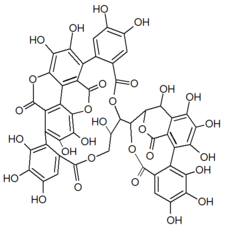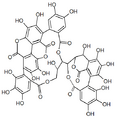Punicacortein C facts for kids
Quick facts for kids Punicacortein C |
|
|---|---|
 |
|
| Identifiers | |
| CAS number | |
| PubChem | |
| SMILES | C1C(C(OC(=O)C2=CC(=C(C(=C2C3=C(C(=C4C5=C3C(=O)OC6=C(C(=C(C7=C(C(=C(C=C7C(=O)O1)O)O)O)C(=C56)C(=O)O4)O)O)O)O)O)O)O)C8C9C(C1=C(C(=C(C(=C1C(=O)O9)C1=C(C(=C(C=C1C(=O)O8)O)O)O)O)O)O)O)O |
|
InChI
InChI=1S/C48H28O30/c49-8-1-5-12(27(56)24(8)53)15-20-18-19-21(47(71)76-39(18)36(65)31(15)60)16(32(61)37(66)40(19)75-46(20)70)13-6(2-9(50)25(54)28(13)57)44(68)74-38(11(52)4-73-43(5)67)42-41-34(63)23-22(48(72)77-41)17(30(59)35(64)33(23)62)14-7(45(69)78-42)3-10(51)26(55)29(14)58/h1-3,11,34,38,41-42,49-66H,4H2
|
|
| Properties | |
| Molecular formula | |
| Molar mass | 0 g mol-1 |
| Except where noted otherwise, data are given for materials in their standard state (at 25 °C, 100 kPa) | |
Punicacortein C is a special kind of natural chemical found in plants. It belongs to a group called ellagitannins. These are complex compounds that plants make.
You can find Punicacortein C in the bark of the Punica granatum tree, which is where pomegranates come from. It is one of many interesting chemicals in this fruit tree.
Contents
What is Punicacortein C?
Punicacortein C is a type of phenolic compound. Phenolic compounds are chemicals that have a special ring structure in their molecules. These compounds are very common in plants. They often help plants protect themselves.
How it's made
This molecule is made up of smaller parts. One important part is called gallagic acid. Think of it like building blocks. Gallagic acid is one of the main blocks that make up Punicacortein C.
Where is Punicacortein C Found?
Punicacortein C is found in the bark of the pomegranate tree. Pomegranates are known for their juicy, red seeds. The bark is the outer layer that protects the tree.
Pomegranate tree facts
The pomegranate tree is native to parts of Asia. It has been grown for thousands of years. People use its fruit for food and drinks. The tree itself can grow quite tall.
Images for kids
See also
 In Spanish: Punicacorteina C para niños
In Spanish: Punicacorteina C para niños


